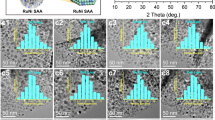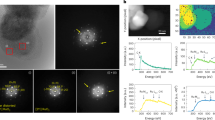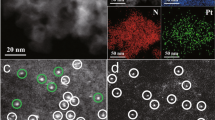Abstract
Single-atom catalysts with uniform metal active sites show potential for selectivity control. However, their application to high-temperature propane dehydrogenation remains challenging. Here we develop a highly stable and efficient single-atom catalyst for propane dehydrogenation that is based on Ru single atoms on nitrogen-doped carbon (Ru1/NC). The turnover frequency of Ru1/NC is at least three times higher than that of nanoparticle counterparts, resulting in propylene selectivity of around 92% with a lower deactivation rate at 560 °C. Experimental and density functional theory studies reveal the important role of peripheral N species around the Ru1 centre. The inner-shell N stabilizes the atomically dispersed Ru to inhibit structure-sensitive propane cracking, while the outer-shell N promotes electron accumulation at the Ru1 centre, inducing a significant charge repulsion between Ru1 and propylene to facilitate its desorption. The combined functions of inner-shell and outer-shell N species at single-atom Ru sites contribute to the high efficiency of Ru1/NC.

This is a preview of subscription content, access via your institution
Access options
Access Nature and 54 other Nature Portfolio journals
Get Nature+, our best-value online-access subscription
$29.99 / 30 days
cancel any time
Subscribe to this journal
Receive 12 digital issues and online access to articles
$119.00 per year
only $9.92 per issue
Buy this article
- Purchase on Springer Link
- Instant access to full article PDF
Prices may be subject to local taxes which are calculated during checkout





Similar content being viewed by others

Data availability
The original data about experiments and DFT calculations in the manuscript are available at https://github.com/FenfeiWei118/RuNC-Data. The data that support the findings of this study are included in the article (and its Supplementary Information) or are available from the corresponding author on reasonable request.
Change history
12 January 2023
A Correction to this paper has been published: https://doi.org/10.1038/s41929-023-00915-6
References
Sattler, J. J. et al. Catalytic dehydrogenation of light alkanes on metals and metal oxides. Chem. Rev. 114, 10613–10653 (2014).
Otroshchenko, T. et al. ZrO2-based alternatives to conventional propane dehydrogenation catalysts: active sites, design, and performance. Angew. Chem. Int. Ed. 54, 15880–15883 (2015).
Carter, J. H. et al. Direct and oxidative dehydrogenation of propane: from catalyst design to industrial application. Green. Chem. 23, 9747–9799 (2021).
Zhu, Y. et al. Lattice-confined Sn (IV/II) stabilizing raft-like Pt clusters: high selectivity and durability in propane dehydrogenation. ACS Catal. 7, 6973–6978 (2017).
Elaine Gomez, S. K. et al. Combining CO2 reduction with propane oxidative dehydrogenation over bimetallic catalysts. Nat. Commun. 9, 1398 (2018).
Hannagan, R. T. et al. First-principles design of a single-atom-alloy propane dehydrogenation catalyst. Science 372, 1444–1447 (2021).
Yang, C. et al. Promotion of Pd nanoparticles by Fe and formation of a Pd3Fe intermetallic alloy for propane dehydrogenation. Catal. Today 323, 123–128 (2019).
Childers, D. J. et al. Modifying structure-sensitive reactions by addition of Zn to Pd. J. Catal. 318, 75–84 (2014).
Cai, W. T. et al. Subsurface catalysis-mediated selectivity of dehydrogenation reaction. Sci. Adv. 4, 5418–5426 (2018).
Grant, J. T. et al. Aerobic oxidations of light alkanes over solid metal oxide catalysts. Chem. Rev. 118, 2769–2815 (2018).
Sun, G. et al. Breaking the scaling relationship via thermally stable Pt/Cu single atom alloys for catalytic dehydrogenation. Nat. Commun. 9, 4454–4462 (2018).
Chen, S. et al. Propane dehydrogenation on single-site [PtZn4] intermetallic catalysts. Chem 7, 387–405 (2021).
Pham, H. N. et al. Role of Sn in the regeneration of Pt/gamma-Al2O3 light alkane dehydrogenation catalysts. ACS Catal. 6, 2257–2264 (2016).
Sun, Q. et al. Subnanometer bimetallic platinum-zinc clusters in zeolites for propane dehydrogenation. Angew. Chem. Int. Ed. 59, 19450–19459 (2020).
Searles, K. et al. Highly productive propane dehydrogenation catalyst using silica-supported Ga-Pt nanoparticles generated from single-sites. J. Am. Chem. Soc. 140, 11674–11679 (2018).
Shi, L. et al. Al2O3 nanosheets rich in pentacoordinate Al3+ ions stabilize Pt-Sn clusters for propane dehydrogenation. Angew. Chem. Int. Ed. 54, 13994–13998 (2015).
Zhao, D. et al. In situ formation of ZnOx species for efficient propane dehydrogenation. Nature 599, 234–238 (2021).
Liu, L. et al. Structural modulation and direct measurement of subnanometric bimetallic PtSn clusters confined in zeolites. Nat. Catal. 3, 628–638 (2020).
Searles, K. et al. Silica-supported isolated gallium sites as highly active, selective and stable propane dehydrogenation catalysts. Chem. Sci. 8, 2661–2666 (2017).
Ma, R. et al. Composition tuning of Ru-based phosphide for enhanced propane selective dehydrogenation. ACS Catal. 10, 10243–10252 (2020).
Tang, Y. et al. Synergy of single-atom Ni1 and Ru1 sites on CeO2 for dry reforming of CH4. J. Am. Chem. Soc. 141, 7283–7293 (2019).
Ali, S. et al. Stability and catalytic performance of single-atom catalysts supported on doped and defective graphene for CO2 hydrogenation to formic acid: a first-principles study. ACS Appl. Nano Mater. 4, 6893–6902 (2021).
Liu, W. et al. Single-atom dispersed Co-N-C catalyst: structure identification and performance for hydrogenative coupling of nitroarenes. Chem. Sci. 7, 5758–5764 (2016).
Qi, H. F. et al. Highly selective and robust single-atom catalyst Ru1/NC for reductive amination of aldehydes/ketones. Nat. Commun. 12, 3295–3305 (2021).
Wang, A. Q. et al. Heterogeneous single-atom catalysis. Nat. Rev. Chem. 2, 65–81 (2018).
Zhang, C. et al. Single-atomic ruthenium catalytic sites on nitrogen-doped graphene for oxygen reduction reaction in acidic medium. ACS Nano 11, 6930–6941 (2017).
Pan, Y. et al. Design of single-atom Co-N5 catalytic site: a robust electrocatalyst for CO2 reduction with nearly 100% CO selectivity and remarkable stability. J. Am. Chem. Soc. 140, 4218–4221 (2018).
Pan, Y. et al. Regulating the coordination structure of single-atom Fe-NxCy catalytic sites for benzene oxidation. Nat. Commun. 10, 4290 (2019).
Wang, X. et al. Regulation of coordination number over single Co sites: triggering the efficient electroreduction of CO2. Angew. Chem. Int. Ed. 57, 1944–1948 (2018).
Zhu, C. Z. et al. Hierarchically porous M-N-C (M= Co and Fe) single-atom electrocatalysts with robust MNx active moieties enable enhanced ORR performance. Adv. Energy Mater. 8, 1801956 (2018).
Liu, W. et al. A durable nickel single-atom catalyst for hydrogenation reactions and cellulose valorization under harsh conditions. Angew. Chem. Int. Ed. 57, 7071–7075 (2018).
Li, X. et al. Cobalt single-atom catalysts with high stability for selective dehydrogenation of formic acid. Angew. Chem. Int. Ed. 59, 15849–15854 (2020).
Cao, L. et al. Dynamic oxygen adsorption on single-atomic ruthenium catalyst with high performance for acidic oxygen evolution reaction. Nat. Commun. 10, 4849 (2019).
Morgan, D. J. Resolving ruthenium: XPS studies of common ruthenium materials. Surf. Interface Anal. 47, 1072–1079 (2015).
Sun, P. et al. Novel Pt/Mg(In)(Al)O catalysts for ethane and propane dehydrogenation. J. Catal. 282, 165–174 (2011).
Siddiqi, G. et al. Catalyst performance of novel Pt/Mg(Ga)(Al)O catalysts for alkane dehydrogenation. J. Catal. 274, 200–206 (2010).
Gallagher, J. R. et al. Structural evolution of an intermetallic Pd-Zn catalyst selective for propane dehydrogenation. Phys. Chem. Chem. Phys. 17, 28144–28153 (2015).
Liu, G. et al. Nature of the active sites of VOx/Al2O3 catalysts for propane dehydrogenation. ACS Catal. 6, 5207–5214 (2016).
Wegrzyniak, A. et al. Catalytic behavior of chromium oxide supported on nanocasting-prepared mesoporous alumina in dehydrogenation of propane. Nanomaterials 7, 249–264 (2017).
Li, X. et al. Enhanced stability of Pt/Al2O3 modified by Zn promoter for catalytic dehydrogenation of ethane. J. Energy Chem. 51, 14–20 (2020).
Otroshchenko, T. & Kondratenko, E. V. Effect of hydrogen and supported metal on selectivity and on-stream stability of ZrO2-based catalysts in non-oxidative propane dehydrogenation. Catal. Commun. 144, 106068 (2020).
Yang, H. B. et al. Atomically dispersed Ni(1) as the active site for electrochemical CO2 reduction. Nat. Energy 3, 140–147 (2018).
Schweitzer, N. M. et al. Propylene hydrogenation and propane dehydrogenation by a single-Site Zn2+ on silica catalyst. ACS Catal. 4, 1091–1098 (2014).
Tang, C. et al. Tailoring acidic oxygen reduction selectivity on single-atom catalysts via modification of first and second coordination spheres. J. Am. Chem. Soc. 143, 7819–7827 (2021).
Kong, N. et al. Single vanadium atoms anchored on graphitic carbon nitride as a high-performance catalyst for non-oxidative propane dehydrogenation. ACS Nano 14, 5772–5779 (2020).
Yang, M. L. et al. First-principles calculations of propane dehydrogenation over PtSn catalysts. ACS Catal. 2, 1247–1258 (2012).
Wang, L. L. et al. Boosting activity and stability of metal single-atom catalysts via regulation of coordination number and local composition. J. Am. Chem. Soc. 143, 18854–18858 (2021).
Sun, X. et al. Tunable catalytic performance of single Pt Atom on doped graphene in direct dehydrogenation of propane by rational doping: a density functional theory study. J. Phy. Chem. C. 122, 1570–1576 (2018).
Zhou, H. et al. Isolated boron in zeolite for oxidative dehydrogenation of propane. Science 372, 76–80 (2021).
Ravel, B. et al. Data analysis for X-ray absorption spectroscopy using IFEFFIT. J. Synchrotron Radiat. C. 12, 537–541 (2005).
Rehr, J. J. et al. Theoretical approaches to X-Ray absorption fine structure. Rev. Mod. Phys. C. 72, 621–654 (2000).
Lin, J. et al. In situ calorimetric study: structural effects on adsorption and catalytic performances for CO oxidation over Ir-in-CeO2 and Ir-on-CeO2 catalysts. J. Phy. Chem. C. 115, 16509–16517 (2011).
Serrano-Ruiz, J. C. et al. Bimetallic PtSn/C catalysts promoted by ceria: application in the nonoxidative dehydrogenation of isobutane. J. Catal. 246, 158–165 (2007).
Bergeret, G. and Gallezot, P. in Handbook of Heretogeneous Catalysis 2nd edn (eds Ertl, G. et al.) 738–765 (Wiley, 2008).
Perdew, J. P. et al. Generalized gradient approximation made simple. Phys. Rev. Lett. 77, 3865–3868 (1996).
Kresse, G. et al. Ab initio molecular dynamics for liquid metals. Phys. Rev. B 47, 558–561 (1993).
Kresse, G. et al. Efficient iterative schemes for ab initio total-energy calculations using a plane-wave basis set. Phys. Rev. B 54, 11169–11186 (1996).
Kresse, G. et al. From ultrasoft pseudopotentials to the projector augmented-wave method. Phys. Rev. B 59, 1758–1775 (1999).
Monkhorst, H. J. et al. Special points for Brillouin-zone integrations. Phys. Rev. B 13, 5188–5192 (1976).
Thonhauser, T. et al. Van der Waals density functional: self-consistent potential and the nature of the van der Waals bond. Phys. Rev. B 76, 125112 (2007).
Acknowledgements
This work was supported by the National Natural Science Foundation of China (grant nos. 22022814, J.L.; 21878283, J.L.; 22178337, X.W.; 22132006, A.W.; 22172159, A.W.; 22108037, Y.Z.; 21973013, S.L.), the Strategic Priority Research Program of the Chinese Academy of Sciences (CAS; grant no. XDB17020100, T.Z.), National Key R&D Program of China (grant no. 2016YFA0202-801, T.Z. and X.W.), the Youth Innovation Promotion Association CAS (grant no. Y2021057, J.L.), Dalian Science Foundation for Distinguished Young Scholars (grant no. 2021RJ10, J.L.), CAS Project for Young Scientists in Basic Research (grant no. YSBR-022, A.W.), the National Natural Science Foundation of Fujian Province, China (grant no. 2020J02025, S.L.) and the ‘Chuying Program’ for the Top Young Talents of Fujian Province (S.L.). Computations were performed at the Hefei Advanced Computing Centre and Supercomputing Centre of Fujian.
Author information
Authors and Affiliations
Contributions
Y.Z. performed the characterizations, catalytic tests and wrote the first draft of the paper. F.W. contributed to the DFT calculations and paper writing. H.Q. performed the synthesis and characterizations of catalyst. Y.C. and L.C. were responsible for catalytic tests. Q.W. helped with the DFT calculations and data analysis. X.L. and Y.X. contributed to XAS testing and data analysis. J.L., S.L., A.W. and X.W. conceived the idea, directed the project and contributed to writing the manuscript. T.Z. proposed the idea behind the research and supervised the project. All the authors discussed the results and commented on the manuscript.
Corresponding authors
Ethics declarations
Competing interests
The authors declare no competing interests.
Peer review
Peer review information
Nature Catalysis thanks Yafei Li and the other, anonymous, reviewer(s) for their contribution to the peer review of this work.
Additional information
Publisher’s note Springer Nature remains neutral with regard to jurisdictional claims in published maps and institutional affiliations.
Supplementary information
Supplementary Information
Supplementary Figs. 1–36 and Tables 1–7.
Rights and permissions
Springer Nature or its licensor (e.g. a society or other partner) holds exclusive rights to this article under a publishing agreement with the author(s) or other rightsholder(s); author self-archiving of the accepted manuscript version of this article is solely governed by the terms of such publishing agreement and applicable law.
About this article
Cite this article
Zhou, Y., Wei, F., Qi, H. et al. Peripheral-nitrogen effects on the Ru1 centre for highly efficient propane dehydrogenation. Nat Catal 5, 1145–1156 (2022). https://doi.org/10.1038/s41929-022-00885-1
Received:
Accepted:
Published:
Issue Date:
DOI: https://doi.org/10.1038/s41929-022-00885-1
This article is cited by
-
Surprised by exceptional stability of confined single-atom cluster catalysts
Science China Materials (2024)
-
Structure-dependence and metal-dependence on atomically dispersed Ir catalysts for efficient n-butane dehydrogenation
Nature Communications (2023)
-
Rationalizing kinetic behaviors of isolated boron sites catalyzed oxidative dehydrogenation of propane
Nature Communications (2023)
-
Bimetallic clusters confined inside silicalite-1 for stable propane dehydrogenation
Nano Research (2023)


